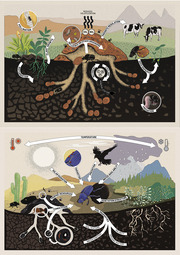- Record: found
- Abstract: found
- Article: found
A trait‐based framework for dung beetle functional ecology

Read this article at
Abstract
-
Traits are key for understanding the environmental responses and ecological roles of organisms. Trait approaches to functional ecology are well established for plants, whereas consistent frameworks for animal groups are less developed. Here we suggest a framework for the study of the functional ecology of animals from a trait‐based response–effect approach, using dung beetles as model system. Dung beetles are a key group of decomposers that are important for many ecosystem processes. The lack of a trait‐based framework tailored to this group has limited the use of traits in dung beetle functional ecology.
-
We review which dung beetle traits respond to the environment and affect ecosystem processes, covering the wide range of spatial, temporal and biological scales at which they are involved. Dung beetles show trait‐based responses to variation in temperature, water, soil properties, trophic resources, light, vegetation structure, competition, predation and parasitism. Dung beetles' influence on ecosystem processes includes trait‐mediated effects on nutrient cycling, bioturbation, plant growth, seed dispersal, other dung‐based organisms and parasite transmission, as well as some cases of pollination and predation.
-
We identify 66 dung beetle traits that are either response or effect traits, or both, pertaining to six main categories: morphology, feeding, reproduction, physiology, activity and movement. Several traits pertain to more than one category, in particular dung relocation behaviour during nesting or feeding. We also identify 136 trait–response and 77 trait–effect relationships in dung beetles.
-
No response to environmental stressors nor effect over ecological processes were related with traits of a single category. This highlights the interrelationship between the traits shaping body‐plans, the multi‐functionality of traits, and their role linking responses to the environment and effects on the ecosystem.
-
Despite current developments in dung beetle functional ecology, many knowledge gaps remain, and there are biases towards certain traits, functions, taxonomic groups and regions. Our framework provides the foundations for the thorough development of trait‐based dung beetle ecology. It also serves as an example framework for other taxa.
Abstract
This paper reviews the current state of the art on trait‐based responses and ecosystem effects of Scarabaeidae dung beetles. It provides synthetic figures that depict their main responses to the environment and key functional roles, which are central to several nutrient cycles and other important functions in many tropical and temperate ecosystems.
Related collections
Most cited references297
- Record: found
- Abstract: found
- Article: not found
Rebuilding community ecology from functional traits.
- Record: found
- Abstract: not found
- Article: not found
New handbook for standardised measurement of plant functional traits worldwide
- Record: found
- Abstract: not found
- Article: not found
